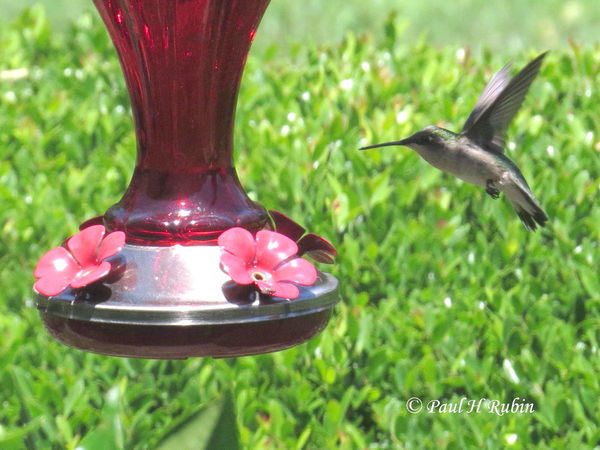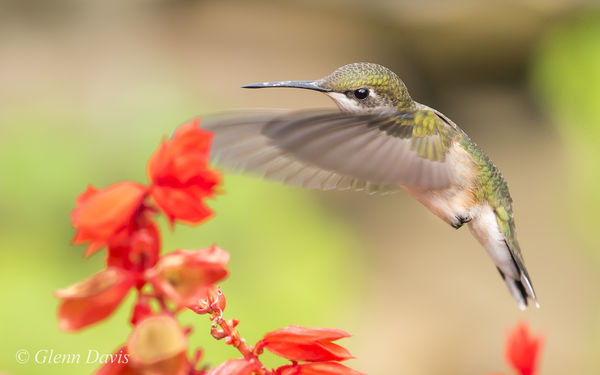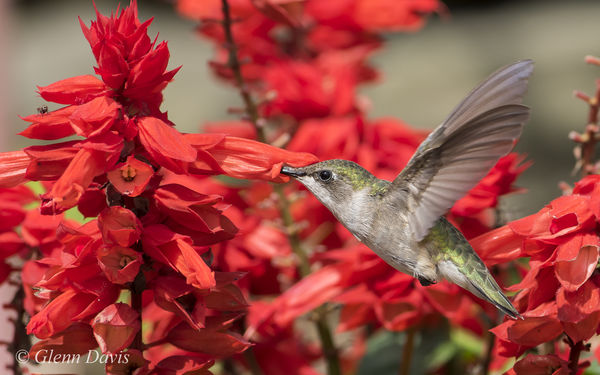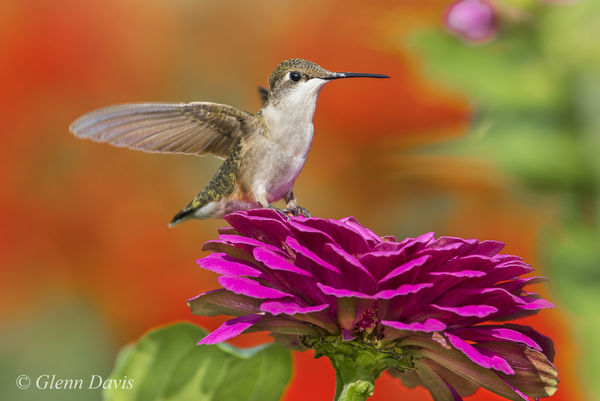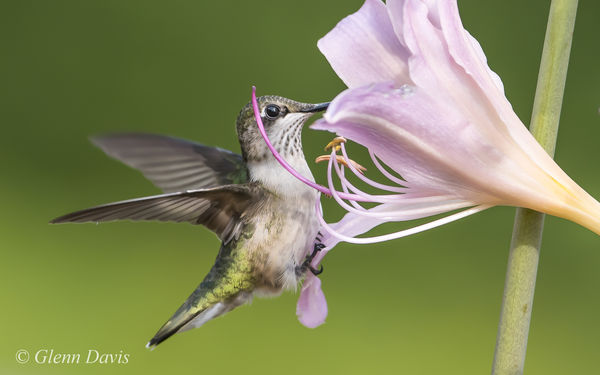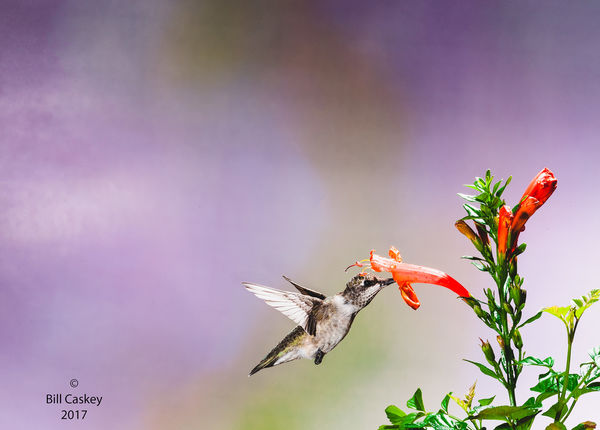Hummingbirds
May 9, 2018 06:45:58 #
I have set out 2 hummingbird feeders and am looking for settings advice to capture these birds feeding. I will be using a Canon T5i with an EFS 55-250 Lens. Conditions this week are due to be sunny. As it will be afternoon I will be watching, the sun should be behind me and I will be shooting from a covered porch. I am newer to DSLR photography so any help would be appreciated.
May 9, 2018 07:02:58 #
You should consider a tripod. Until then, set your camera manually with the IS active and try 1/4000 and f/8 with auto ISO in bright sun. Set the focus to just a single point in the middle. Set the AF mode to AI Servo and the Drive Mode to Continuous. If you have the focus confirmation to beep, you'll want to turn that off.
You'll have to experiment and try adjusting just the shutterspeed down to say 1/1000, particularly on the less sunny days / times. You can try Shutter Priority where you control the speed between 1/1000 and 1/4000 and let the camera automatically control the aperture, leaving the ISO on auto. Try to position the AF point over the eye of the bird. Shoot hundreds / thousands of images holding the shutter button down for bursts of 3 to 10 images at a time. Sort through the results on your computer later to find the best results and the settings that produced the best results. You can also try the Sport setting on the camera. It will take some practice and learning from doing, but when you get to the point you're consistently producing spectacular results, all the practice makes it worth the effort. Consult your manual for how each setting is adjusted and to learn more background details on the individual settings.
You'll have to experiment and try adjusting just the shutterspeed down to say 1/1000, particularly on the less sunny days / times. You can try Shutter Priority where you control the speed between 1/1000 and 1/4000 and let the camera automatically control the aperture, leaving the ISO on auto. Try to position the AF point over the eye of the bird. Shoot hundreds / thousands of images holding the shutter button down for bursts of 3 to 10 images at a time. Sort through the results on your computer later to find the best results and the settings that produced the best results. You can also try the Sport setting on the camera. It will take some practice and learning from doing, but when you get to the point you're consistently producing spectacular results, all the practice makes it worth the effort. Consult your manual for how each setting is adjusted and to learn more background details on the individual settings.
May 9, 2018 11:45:38 #
I think 1/4000 is rather fast unless you want to freeze the wings. They can be stopped with a slower shutter speed if you catch them at end of stroke as here. This was done with a Canon SX50 HS @ 1/1000, ISO 400, F5.6, fl 308mm (35mm equiv).
May 9, 2018 12:30:06 #
PHRubin wrote:
I think 1/4000 is rather fast unless you want to freeze the wings. They can be stopped with a slower shutter speed if you catch them at end of stroke as here. This was done with a Canon SX50 HS @ 1/1000, ISO 400, F5.6, fl 308mm (35mm equiv).
This sounds right.
To the OP how far will you be from the feeder? If you are 30 ft away, at 200mm and f5.6 you would have around a foot and a half of DOF which should be plenty to allow you to pre-focus.
May 10, 2018 05:51:31 #
Thanks for the advice. I will be about 20-30ft from the feeders. I am just waiting for the birds to show up now to put your suggestions to use!
May 10, 2018 07:55:39 #
Yes, pre-focus where you see the hummingbirds landing, also depending where you are, meaning in USA or South America you’ll need to remain still, no sudden moves, as they respond immediately and leave. In my experience depending how many hummers you have, they come and go every 15 to 20 minutes. I live in New York and only have a few hummers and when I go to Ecuador to Mindo they are plentiful and are used to having their pictures taken and you can shoot all day long.....happy shooting!!!!
May 10, 2018 08:10:38 #
GED
Loc: North central Pa
BristolDave wrote:
Thanks for the advice. I will be about 20-30ft from the feeders. I am just waiting for the birds to show up now to put your suggestions to use!
Dave when I shoot hummers I try to be within 10 to 15 ft of where they are feeding (generally in gardens), even though the birds come quite close when I am just standing there with no equipment once I go out with tripod and gear they are much more cautious of coming in close. I prefer a fast lens f2.8 as it allows the shutter speed usually around 1000th sec at a lower ISO and also gives a cleaner out of focus background. The hummers will return regularly to particular plants if you watch them you know where they will come, I set up to shoot the first two hours of morning light when the light quality is nice and gives a direct light with minimal shadows. A typical morning 2hrs will usually net me about 10 to 20 good shots. I also work from a blind. I use the center point autofocus, matrix metering, and my camera allows me to let the ISO float and maintain a minimum preset shutter speed usually around 1000th second. By trying to stay within 10 to 15 ft of my subjects I've found it allows me to shoot with a 300 or 400mm lens and is easier to keep the focus dot on the bird because they are larger in the viewfinder. I find it much easier to find and pick up the birds as they dart around the garden with the 300 and 400mm compared to a longer focal length. Here are a few shots using the methods I described. Best of luck to you I look forward to seeing some of your work.

May 10, 2018 08:19:15 #
May 10, 2018 09:07:40 #
My most successful hummingbird photos at feeders were done after first watching the birds behavior over a particular location at the feeder You will note the birds with dart into feeder to feed then have a hover position just off the feeder by a few inches. This is where I prefocused the location and waited to shoot. The advantage of this was that I was able to exclude the feeder in the images. Following hummers around in flowers is worse than following butterflies! Let the hummers come to you for a specific shot & location, if possible. Also determine the best time of the day to achieve the optimal lighting, such as having the birds in full sunlight and a darker background. Shooting at minimally at 1/1000 is fine. Stopping the wings are not that important. Getting in focus their beak and sometimes the tongue and eyes & head will make for an effective image. Good luck!
May 10, 2018 09:22:01 #
Glen, those are fantastic shots of Hummers. I'm going to try the blind and telephoto plan that you use. It makes a lot of sense. If the are larger in the frame they are easier to photograph. Thanks for sharing that.
May 10, 2018 09:52:44 #
Those are some beautiful hummer shots Glen. Great advice too. Thanks.
May 10, 2018 09:58:09 #
Personally, I would place, or pick a location where a perch is available for the birds. I don't like the feeders in my image. Placing sugar water in a flower is a good method. Get the birds familiar with a location of a feeder. Then, remove the feeder and replace it with a flower and sugar water. Try this method and consider using some fill flash as well.
May 10, 2018 10:34:25 #
use a flash , it will freeze the action , and a cloudy day would be best with flash .you could use the better beamer add on to the flash for extra distance .
May 10, 2018 11:19:46 #
GED (Glen Davis) images are very sharp and expert looking. I'm sure he has invested in some really expensive glass for those images although he removed all the EXIF information so that we can't see his settings and equipment models so I'm not 100% sure.
I too am a stickler about shooting hummers with feeders in the picture. Put the feeders near trees or other flowers so that when the hummers come to feed, they will be attracted to natural flowers or perhaps wait on a nearby tree branch while it waits it's turn to feed at your feeder. You can also try putting cut flowers near your feeder and add sugar water, as someone else already pointed out, and get some more natural images while they feed from real flowers.
You may not get the same results with your kit lens as GED has shown you, but after you have done this for a while, you might be inclined to upgrade your lens if this winds up being something you decide to stick with. Good Luck with your pictures of hummingbirds.
I too am a stickler about shooting hummers with feeders in the picture. Put the feeders near trees or other flowers so that when the hummers come to feed, they will be attracted to natural flowers or perhaps wait on a nearby tree branch while it waits it's turn to feed at your feeder. You can also try putting cut flowers near your feeder and add sugar water, as someone else already pointed out, and get some more natural images while they feed from real flowers.
You may not get the same results with your kit lens as GED has shown you, but after you have done this for a while, you might be inclined to upgrade your lens if this winds up being something you decide to stick with. Good Luck with your pictures of hummingbirds.
May 10, 2018 11:43:59 #
wapiti wrote:
Personally, I would place, or pick a location where a perch is available for the birds. I don't like the feeders in my image. Placing sugar water in a flower is a good method. Get the birds familiar with a location of a feeder. Then, remove the feeder and replace it with a flower and sugar water. Try this method and consider using some fill flash as well.
Those are a couple of beauties Bill. The second one is a stunner.
If you want to reply, then register here. Registration is free and your account is created instantly, so you can post right away.


